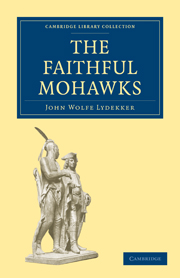Book contents
- Frontmatter
- Contents
- ILLUSTRATIONS
- FOREWORD BY THE RIGHT HONOURABLE LORD TWEEDSMUIR, G.C.M.G., C.H.
- PREFACE
- ABBREVIATIONS
- INTRODUCTION
- Chapter I PRELUDE (1664–1704)
- Chapter II THE FIRST DECADE (1704–1713)
- Chapter III THE NEXT THIRTY-THREE YEARS (1714–1746)
- Chapter IV THE CONFLICT FOR CANADA (i) (1747–1755)
- CHAPTER V THE CONFLICT FOR CANADA (ii) (1756–1760)
- CHAPTER VI THE YEARS BETWEEN (1761–1774)
- CHAPTER VII THE REVOLUTIONARY WAR (1775–1782)
- CHAPTER VIII “THE FAITHFUL MOHAWKS” (1783–1807)
- Appendix
- BIBLIOGRAPHY
- INDEX
- Plate section
Chapter I - PRELUDE (1664–1704)
Published online by Cambridge University Press: 07 September 2010
- Frontmatter
- Contents
- ILLUSTRATIONS
- FOREWORD BY THE RIGHT HONOURABLE LORD TWEEDSMUIR, G.C.M.G., C.H.
- PREFACE
- ABBREVIATIONS
- INTRODUCTION
- Chapter I PRELUDE (1664–1704)
- Chapter II THE FIRST DECADE (1704–1713)
- Chapter III THE NEXT THIRTY-THREE YEARS (1714–1746)
- Chapter IV THE CONFLICT FOR CANADA (i) (1747–1755)
- CHAPTER V THE CONFLICT FOR CANADA (ii) (1756–1760)
- CHAPTER VI THE YEARS BETWEEN (1761–1774)
- CHAPTER VII THE REVOLUTIONARY WAR (1775–1782)
- CHAPTER VIII “THE FAITHFUL MOHAWKS” (1783–1807)
- Appendix
- BIBLIOGRAPHY
- INDEX
- Plate section
Summary
The mohawk tribe of Indians of North America claim the distinction of being the progenitors of Hiawatha, the legendary “maker of rivers” whose far-reaching influence is said to have induced the Mohawks, Oneidas, Onondagas, Cayugas, and Senecas to form themselves into the defensive league of the Iroquois. These tribes were originally a nation of one stock of eight clans which gradually separated into the five sections known as the “Five Nations”. They inhabited a territory which extended from the Genesee to the Mohawk Rivers and included the area between Lakes Huron and Erie.
The five tribes forming the Iroquois confederacy (which emerges into historic form towards the end of the sixteenth century) possessed a common medium in the Iroquoian stock language, of which each tribe spoke its own dialect. These dialects were sufficiently akin to be mutually understood for the purposes of deliberation, and by means of this lingua franca a general council of fifty chiefs or sachems was evolved which administered the affairs of the league. The tribes were, however, distinct as regards their own individual government, and they possessed separate territories and jurisdiction. In questions of peace or war each tribe was free to act on its own initiative, and the other members of the confederation were not bound to co-operate unless they had given their assent at a general council of the league. For military purposes the supreme command was vested in two war-chiefs of equal authority who were chosen by the general council.
- Type
- Chapter
- Information
- The Faithful Mohawks , pp. 1 - 15Publisher: Cambridge University PressPrint publication year: 2010First published in: 1938



